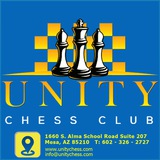In attacking the rook, Black naively counted on ensuring a favourable exchange of light-squared bishops on g2. However, he forgot about the safety of his Bb4, which has only one retreat square. There followed:
White gets two bishops for rook and pawn, and the rook currently lacks operating space. Black’s chances of saving the game are few.
14...Re8 15.Qd1 e4 16.Be2 c6 17.axb4 axb4 18.Bd2 Qb6 19.Rc1 c5 20.Qb3
White’s centre is very strong, and after a series of general strengthening moves, there will follow the break f2-f3, deciding the outcome.
20...Ra5 21.Kg2 g6 22.h4 h5 23.Rd1 Rd8 24.Qc2 f5 25.dxc5 dxc5 26.f3 exf3+ 27.Bxf3 Qf6 28.e4 fxe4 29.Bxe4 Ra2 30.Bc1 Rf8 31.d6 Kh7 32.Qxc5 Ra5 33.Qxa5 Qf2+ 34.Kh3 Qe2 35.Bxg6+
Unity Chess Club
Eduard Meduna 2485 Yuri Yakovich 2440 Sochi 1986 White to move
Despite the fact that the black king is stuck in the centre, White cannot break through the row of strong black pawns. But the piece which comes to his rescue is the black queen, trapped in White’s camp:
18...Kf7 19.Bd2 Qc4 20.Rxc4 dxc4 21.Ne5+ fxe5 22.Qe2 Rd5 23.Qxc4 Be7 24.Bc3 Rb8 25.Bxe5 Rb4 26.Qc3 Bf8 27.Bxg7
Unity Chess Club
Efim Geller Vasily Smyslov Moscow 1964 White to move
White has an advantage in development, but for the moment, the opponent’s position is held together by the powerful Nd5. In compensation, his colleague on a4 is out of play. Can we somehow exploit this?
The last move opens the a-file, deflecting the pawn from the square b4, and allowing White to create irresistible threats to trap the black knight.
